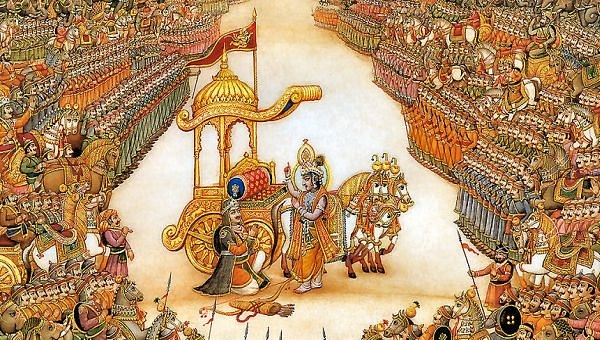
The Universal Relevance of Sanatana Dharma
Hinduism has always been a universal tradition and India has been its geographical centre, not its limiting location.
As a western Hindu, I have sometimes been told that I can’t truly be a Hindu because I wasn’t born one. One encounters this opinion not only in India but throughout the world, where many non-Hindus think that being a Hindu is by birth only.
Recently, an Indian writer on mythology stated that Hindus should not look to the books of white westerners for their study of Hinduism – even the books of western Hindus – because they weren’t born Hindus. This kind of reverse racism, understandable to some degree because of biased anti-Hindu attitudes from the colonial era, is contrary to the deeper truth of Hindu Dharma that does not circumscribe its teachings in any historical, geographical or ethnic boundaries. That Hindus do not proselytise does not mean that Hindu Dharma is limited to a community of birth and is not of any universal relevance.
Ever since Swami Vivekananda brought the teachings of Yoga and Vedanta to the world in 1893, Hindu-based teachings have been spreading worldwide. This extends to all aspects of Yoga – not only asanas but also pranayama, mantra, and meditation, and now kirtan is a popular musical movement in the West. Ayurveda is similarly gaining a global following as a profound system of mind-body medicine. Sanskrit, Indian music and dance are expanding their influences as well. A global tradition now exists of numerous Hindu gurus travelling and teaching before millions of followers from all levels of society and relative to all aspects of life.
The Hindu diaspora is another important component of the new global Hindu movement. Hinduism is gaining respect owing to the success financially and educationally of immigrant Hindus, as well as their peaceful and tolerant nature. Beautiful Hindu temples can be found in the main cities of the West, which westerners are also visiting. The number of westerners formally becoming Hindus is slowly increasing through the efforts of organisations like Hinduism Today, Vishwa Hindu Parishad and Arya Samaj.
Unfortunately, there has been considerable distortion and commercialisation of Hindu teachings in the West, as with some Yoga groups downplaying or denying the Hindus basis of the practices they follow. This needs to be addressed by a proper presentation of the teachings, not by trying to limit these practices only to those born in India. The new globalisation of Hindu Dharma should be promoted in an authentic manner for the benefit of all humanity.
Historical Spread of Dharmic Traditions
We should remember that Hindu, Vedic and Dharmic teachings have had a wide geographical influence for thousands of years. Their modern impact is only a new phase of the development of Hindu Dharma in its universal relevance.
It is well known that Buddhism spread throughout Asia over the past 2,500 years, but people forget that Hinduism also spread widely and from an earlier era. Hinduism was prominent in Indonesia, where Bali remains a pocket of its former influence, and in Indochina, where Cambodia’s Angkor Wat of a thousand years ago remains the largest Hindu temple in the world. Hinduism along with Buddhism spread into Central Asia along the Silk Route from China to Europe. The Hindu Ramayana remains the most popular story of Southeast Asia.
Such Hindu groups outside India were clearly not born in the Indian subcontinent. The geographical idea of Hinduism as limited to India or Hindustan is a modern idea coming from western invaders, not the actual history of Hinduism. Hinduism has long shared its teachings with a wide variety of countries, cultures and ethnic groups.
World Vedic Heritage
There is yet a greater world Vedic heritage extending through many cultures of the ancient world, East and West.
Vedic related teachings and traditions dominated Europe, West and Central Asia, as well as India going back 5,000 years, including various Indo-European groups like the ancient Germans, Slavs, Celts, Thracians, Greeks and Romans. The Hittites and Mittani dominated West Asia 4,000 years ago, with Mittani dynasties with Vedic names intermarrying with the pharaohs of Egypt.
Vedic teachings spread north and west from India through the Scythians and Iranians, who dominated West and Central Asia from the second millennium BCE to the later period of the Roman Empire. These groups followed similar traditions as the Vedas, with their sacred fire worship and honouring of the Sun. The Zoroastrians are only one such group with Vedic affinities.
The ancient Greeks and Romans had a religion that resembles Hinduism, with temples, iconic worship of deities, and similar traditions of philosophy, medicine and astrology. The ancient Middle East extending from Mesopotamia to Saudi Arabia had similar deities and forms of worship as the Hindu, with gods, goddesses, icons and temple worship in the pre-Islamic era, including an extensive trade with India.
Hinduism as Sanatana Dharma
We must remember that the term Hinduism is only a modern designation of a tradition properly known as “Sanatana Dharma”, the eternal or universal Dharma. Once we understand Hinduism as Santana Dharma, its relevance for all humanity becomes clear. We can easily set aside the misunderstanding that one must be born a Hindu, or that Hindu is merely a geographical term. Anyone who truly follows the principles and practices of Sanatana Dharma is a Hindu.
Hinduism has always been a universal tradition and India has been its geographical centre, not its limiting location. Hinduism has shared the expansive nature of Indian civilisation with its great tradition of travel and trade by sea and land, such as the terms Indonesia and Indochina reflect.
One must remember the ancient prayer of the most ancient Rigveda, Krinvanto Vishvam Aryam, “Make the Entire World noble”. Sanatana Dharma has the universal vision to link all humanity together in a recognition of the One Self or Paramatman in all beings – the unitary consciousness behind and beyond all time, space, karma and manifestation, such as the Upanishads and Bhagavad Gita proclaim.